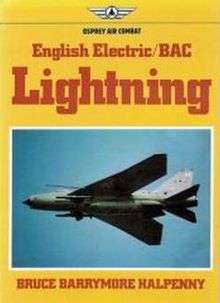English Electric/BAC Lightning (book)

The English Electric/BAC Lightning (ISBN 978-0850455625) is an aviation book by British military historian and author Bruce Barrymore Halpenny about the English Electric Lightning. It was published by Osprey Publishing as part of their Air Combat series. It was a best seller in Grimsby,[1] the home town of the Lightning.[2]
The author, known for his books on airfields and aircraft,[3] spent nine months researching the Lightnings[2] with the pilots of 5 and 11 Squadrons and Binbrook’s own Lightning Training Flight.[2] To gather information for the book, the author talked to men like, Sqdn Ldr Dave Carden (with 3,000 plus hours, the most experienced Lightning pilot in the world) and fellow pilots and ground staff.[2]
Included in the book are several anecdotes, one being a pilot's super sonic flight causing "anger and dismay". Thirty minutes after landing at RAF Binbrook,[3] the hapless airman took a telephone call... as Flt Lt Normant Want recalls in the book,
"It was from the Mayor of Bridlington who was complaining about an aircraft that had dropped a supersonic boom on Bridlington and the surrounding area. The boom had broken lots of windows. But the thing that really annoyed him was that the sonic boom sounded just like the signal to launch the lifeboat - which was now in the middle of the North Sea. The Mayor was not too impressed with all this. I did the hot-foot dance routine that most young lads go through when the've been nicked. It was about half a day later that the Ground Controlled Interception controller let me off the hook. He 'phoned to tell me that he had been responsible and that it wasn't the Mayor of Bridlington after all!"[3]
The book itself gives an insight into the workings of RAF Binbrook, its Lightnings, and the men that fly and maintain them.[2] Sqdn Ldr Dave Carden takes the reader on a typically "hair-raising mission",[2] while another section is devoted to a pilot's experiences when his aircraft caught fire and crashed into the sea off Flamborough Head in 1981.[2] It also deals with the Quick Reaction Alert shed, where two fully armed Lightnings and their pilots were on constant standby to intercept Russian aircraft which used to sometimes fly to within 100 miles of Spurn Point.[2]
References
- ↑ Information Desk - Information Supplied by Albert Gait Ltd - Evening Telegraph - Tuesday, January 22, 1985
- 1 2 3 4 5 6 7 8 Struck by Lightning - by Pat Otter - Evening Telegraph - Monday, November 12, 1984
- 1 2 3 Lightning blamed for coast boom - Book Reviews - by Steve Anderson - The Daily Mail - Monday, December 17, 1984